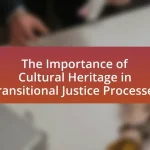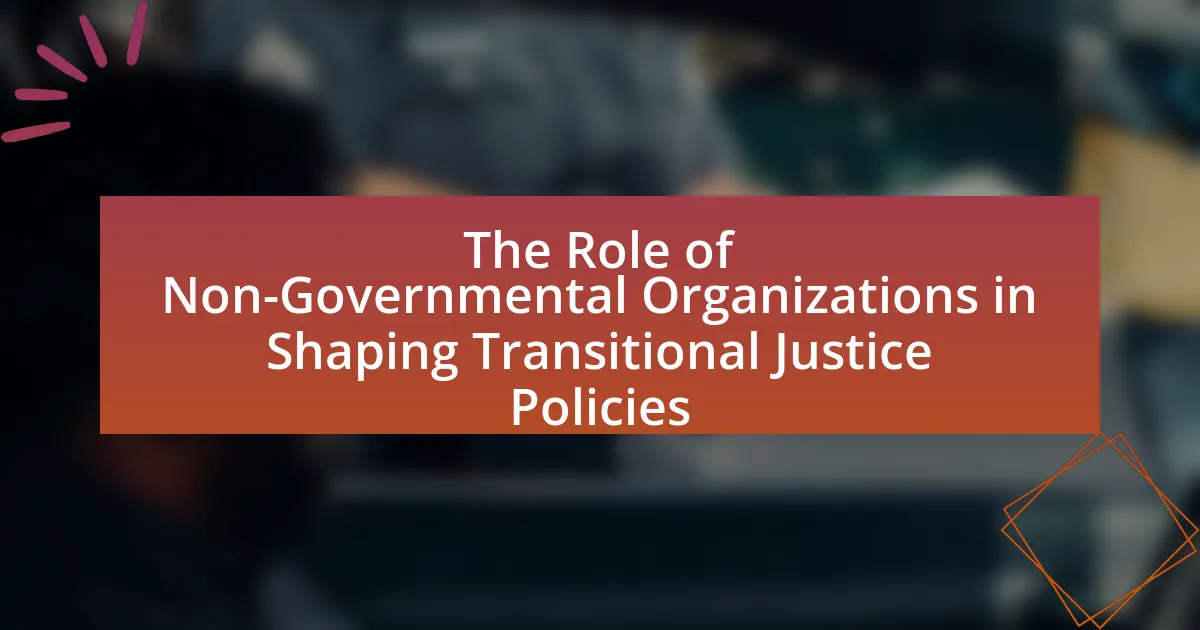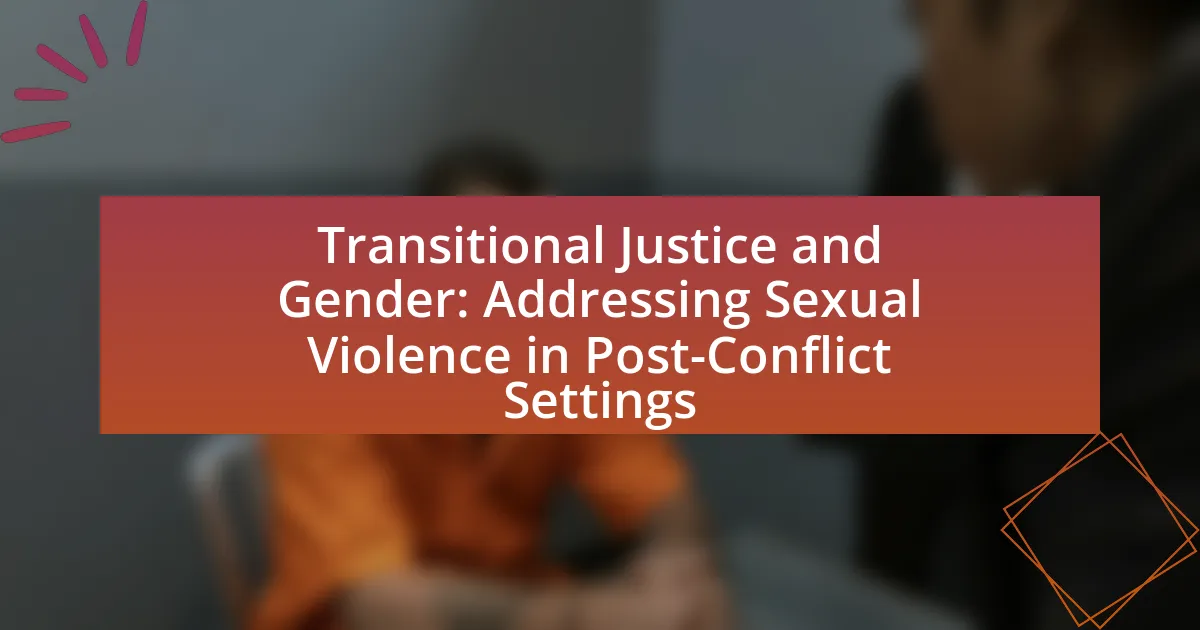Reparations in transitional justice frameworks are measures aimed at addressing the harm suffered by victims of human rights violations during conflicts or authoritarian regimes. This article evaluates the effectiveness of reparations, exploring their importance in acknowledging past injustices, promoting healing, and fostering societal reconciliation. It examines various forms of reparations, including financial compensation, restitution, and symbolic measures, while also addressing the challenges faced in their implementation. Additionally, the article highlights the impact of reparations on victims and communities, the role of public perception, and best practices for designing effective reparations programs.
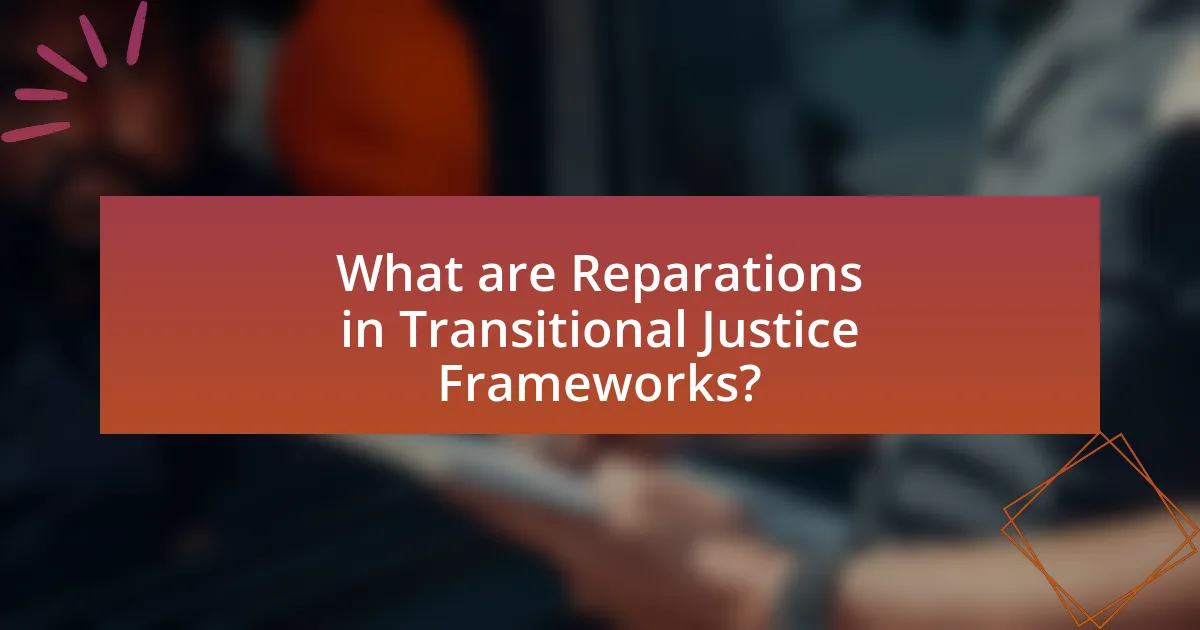
What are Reparations in Transitional Justice Frameworks?
Reparations in transitional justice frameworks are measures taken to address the harm suffered by victims of human rights violations during periods of conflict or authoritarian rule. These measures can include financial compensation, restitution of property, rehabilitation services, and public acknowledgment of the wrongs committed. The purpose of reparations is to provide redress, promote healing, and restore dignity to victims, thereby contributing to societal reconciliation and preventing future violations. Historical examples, such as the reparations paid to Holocaust survivors by Germany, illustrate the potential impact of such measures on both individual victims and broader societal healing processes.
Why are Reparations Important in Transitional Justice?
Reparations are important in transitional justice because they serve to acknowledge and address the harms suffered by victims of past injustices. By providing financial compensation, restitution of property, or services, reparations facilitate healing and reconciliation within societies recovering from conflict or authoritarian rule. Historical examples, such as the reparations paid to Holocaust survivors by Germany, demonstrate that such measures can contribute to societal healing and recognition of suffering, thereby fostering a sense of justice and closure for affected individuals. Additionally, reparations can help prevent future violations by establishing a societal commitment to accountability and human rights, as seen in post-apartheid South Africa, where reparations were part of a broader strategy to address the legacy of systemic injustice.
What historical contexts necessitate Reparations?
Reparations are necessitated by historical contexts involving systemic injustices, such as slavery, colonialism, and genocide. For instance, the transatlantic slave trade resulted in profound economic and social disparities for African descendants, necessitating reparative measures to address the long-term impacts of enslavement and discrimination. Additionally, the Holocaust led to the establishment of reparations for Jewish survivors, recognizing the atrocities committed and the need for restitution. Historical injustices create enduring inequalities, which reparations aim to rectify by acknowledging past wrongs and providing compensation or support to affected communities.
How do Reparations contribute to healing and reconciliation?
Reparations contribute to healing and reconciliation by addressing historical injustices and acknowledging the suffering of affected communities. This acknowledgment fosters a sense of validation and recognition, which is essential for psychological healing. For instance, studies have shown that reparative measures, such as financial compensation or public apologies, can significantly reduce feelings of resentment and promote social cohesion. The Truth and Reconciliation Commission in South Africa demonstrated that reparations helped victims process trauma and facilitated dialogue between communities, ultimately aiding in national healing. Thus, reparations serve as a crucial mechanism for restoring dignity and fostering relationships among previously divided groups.
What Types of Reparations Exist?
There are several types of reparations that exist, including financial compensation, restitution of property, rehabilitation services, and symbolic measures. Financial compensation provides monetary payments to victims for their suffering, while restitution involves returning property or assets taken during injustices. Rehabilitation services focus on medical, psychological, and social support to help victims recover. Symbolic measures, such as public apologies or memorials, acknowledge the harm done and promote healing. These reparations aim to address the consequences of past injustices and contribute to the broader goals of transitional justice.
What are the different forms of reparations (monetary, symbolic, etc.)?
Reparations can take various forms, primarily categorized into monetary, symbolic, and material reparations. Monetary reparations involve direct financial compensation to victims or their families, often seen in cases of state-sponsored violence or discrimination, such as the payments made to Japanese Americans interned during World War II. Symbolic reparations include public acknowledgments of wrongdoing, apologies, and memorials, which serve to recognize the suffering of victims and promote healing, as exemplified by the Truth and Reconciliation Commission in South Africa. Material reparations encompass the provision of services, such as healthcare, education, and housing, aimed at restoring the dignity and well-being of affected individuals, as seen in various post-conflict societies. Each form of reparation plays a crucial role in addressing historical injustices and fostering societal healing.
How do these forms of reparations address various injustices?
Forms of reparations address various injustices by providing financial compensation, acknowledgment of harm, and restoration of dignity to affected communities. Financial compensation directly addresses economic disparities created by historical injustices, such as slavery or colonialism, by redistributing resources to marginalized groups. Acknowledgment of harm serves to validate the experiences of victims, fostering a sense of justice and recognition that is essential for healing. Restoration of dignity often includes public apologies and memorialization efforts, which help to rectify historical narratives and promote societal reconciliation. For example, the South African Truth and Reconciliation Commission highlighted the importance of acknowledgment in healing post-apartheid society, demonstrating that reparations can effectively address both individual and collective injustices.
How are Reparations Evaluated in Transitional Justice Frameworks?
Reparations in transitional justice frameworks are evaluated based on their ability to address the harm suffered by victims, restore dignity, and promote reconciliation. This evaluation typically involves assessing the adequacy, accessibility, and effectiveness of reparative measures, such as financial compensation, restitution of property, and public acknowledgment of wrongdoing. For instance, the United Nations Principles on Reparations outline that reparations should be proportional to the gravity of the violations and the harm suffered, emphasizing the need for a victim-centered approach. Additionally, empirical studies, such as those conducted by the International Center for Transitional Justice, demonstrate that successful reparations contribute to societal healing and can reduce the likelihood of future conflicts, thereby validating the importance of thorough evaluation in transitional justice processes.
What criteria are used to assess the effectiveness of reparations?
The criteria used to assess the effectiveness of reparations include acknowledgment of harm, restitution, rehabilitation, satisfaction, and guarantees of non-repetition. Acknowledgment of harm involves recognizing the injustices suffered by victims, which is essential for validating their experiences. Restitution refers to restoring victims to their original situation, such as returning property or compensating for losses. Rehabilitation focuses on providing medical, psychological, and social support to help victims recover. Satisfaction encompasses measures that promote healing, such as public apologies or memorialization of events. Guarantees of non-repetition ensure that the conditions leading to the harm do not recur, often through legal reforms or institutional changes. These criteria are supported by frameworks established in international human rights law, such as the United Nations Basic Principles and Guidelines on the Right to a Remedy and Reparation.
How do stakeholders influence the evaluation process?
Stakeholders significantly influence the evaluation process by shaping the criteria, methods, and outcomes of assessments. Their involvement ensures that diverse perspectives are considered, which can lead to more comprehensive evaluations. For instance, stakeholders such as victims, community leaders, and policymakers provide essential insights that help define what success looks like in the context of reparations. Research indicates that stakeholder engagement can enhance the legitimacy and acceptance of evaluation findings, as seen in the work of the United Nations Development Programme, which emphasizes participatory approaches in transitional justice evaluations. This engagement not only enriches the evaluation process but also fosters accountability and transparency, ultimately leading to more effective reparations.

What Challenges Exist in Implementing Reparations?
Implementing reparations faces significant challenges, including legal, political, and social obstacles. Legal challenges arise from the difficulty in establishing a clear framework for eligibility and the complexity of determining the appropriate compensation for historical injustices. Political challenges include resistance from governments or institutions that may be reluctant to acknowledge past wrongs or allocate resources for reparations. Socially, there is often a lack of consensus within communities about the need for reparations, which can lead to divisions and hinder progress. For instance, in the United States, discussions around reparations for slavery have been met with polarized opinions, complicating legislative efforts. These challenges highlight the multifaceted nature of reparations and the need for comprehensive strategies to address them effectively.
What are the common obstacles to effective reparations?
Common obstacles to effective reparations include political resistance, lack of consensus on what constitutes adequate reparations, and insufficient funding. Political resistance often arises from those in power who may fear losing influence or resources. Additionally, differing opinions among stakeholders about the form and extent of reparations—whether financial compensation, land restitution, or public acknowledgment—can hinder progress. Insufficient funding limits the ability to implement reparations programs effectively, as seen in various transitional justice cases where promised reparations remain unfulfilled due to budget constraints. These factors collectively impede the realization of reparations, undermining their intended impact on justice and reconciliation.
How do political and social contexts impact reparations implementation?
Political and social contexts significantly impact reparations implementation by influencing public opinion, legislative support, and the prioritization of historical injustices. For instance, in countries with strong social movements advocating for racial or economic justice, such as South Africa post-apartheid, reparations have been more actively pursued and integrated into national policy. Conversely, in political environments where there is resistance to acknowledging past injustices, such as in the United States regarding slavery reparations, implementation faces substantial obstacles. Research indicates that the success of reparations initiatives often correlates with the level of political will and societal consensus on the need for redress, as seen in the case of Germany’s reparations to Holocaust survivors, which were facilitated by a strong political commitment and societal acknowledgment of guilt.
What role does public perception play in the success of reparations?
Public perception significantly influences the success of reparations by shaping political will and societal acceptance. When the public views reparations as a just and necessary response to historical injustices, it fosters support among policymakers, which is crucial for implementing reparative measures. For instance, surveys indicate that in contexts where public awareness and understanding of historical injustices are high, such as in South Africa post-apartheid, there is greater backing for reparations initiatives. Conversely, negative public perception can lead to resistance, as seen in various countries where reparations proposals faced backlash due to perceived unfairness or lack of understanding of the issues at hand. Thus, public perception acts as a barometer for the feasibility and effectiveness of reparations within transitional justice frameworks.
How can these Challenges be Overcome?
Challenges in evaluating the effectiveness of reparations in transitional justice frameworks can be overcome by implementing comprehensive monitoring and evaluation systems. These systems should include clear metrics for success, such as community satisfaction, restoration of dignity, and measurable impacts on social cohesion. Research indicates that countries like South Africa and Rwanda have utilized such frameworks to assess the outcomes of their reparative measures, leading to improved accountability and adjustments in policy. By establishing participatory approaches that involve affected communities in the evaluation process, stakeholders can ensure that the reparations are relevant and effective, thereby addressing the challenges faced in transitional justice.
What strategies have proven effective in similar contexts?
Strategies that have proven effective in evaluating reparations within transitional justice frameworks include comprehensive stakeholder engagement, transparent processes, and the integration of local cultural contexts. Comprehensive stakeholder engagement ensures that the voices of affected communities are heard, which has been shown to enhance the legitimacy and acceptance of reparations programs, as evidenced by the South African Truth and Reconciliation Commission’s approach. Transparent processes foster trust and accountability, which are critical for the success of reparations initiatives; for instance, the reparations program in Argentina included clear criteria and public reporting, leading to greater public confidence. Additionally, integrating local cultural contexts into reparations design, as seen in the case of indigenous reparations in Canada, has led to more meaningful and effective outcomes, as these initiatives resonate more deeply with the affected populations.
How can community involvement enhance reparations efforts?
Community involvement can enhance reparations efforts by fostering trust, ensuring that the needs of affected populations are accurately represented, and promoting accountability. Engaging communities in the reparations process allows for the identification of specific grievances and the development of tailored solutions that resonate with those impacted. For instance, the Truth and Reconciliation Commission in South Africa highlighted the importance of community participation in shaping reparative measures, which led to more effective and accepted outcomes. Additionally, studies show that when communities are actively involved, there is a higher likelihood of successful implementation and sustainability of reparations programs, as seen in various transitional justice frameworks globally.
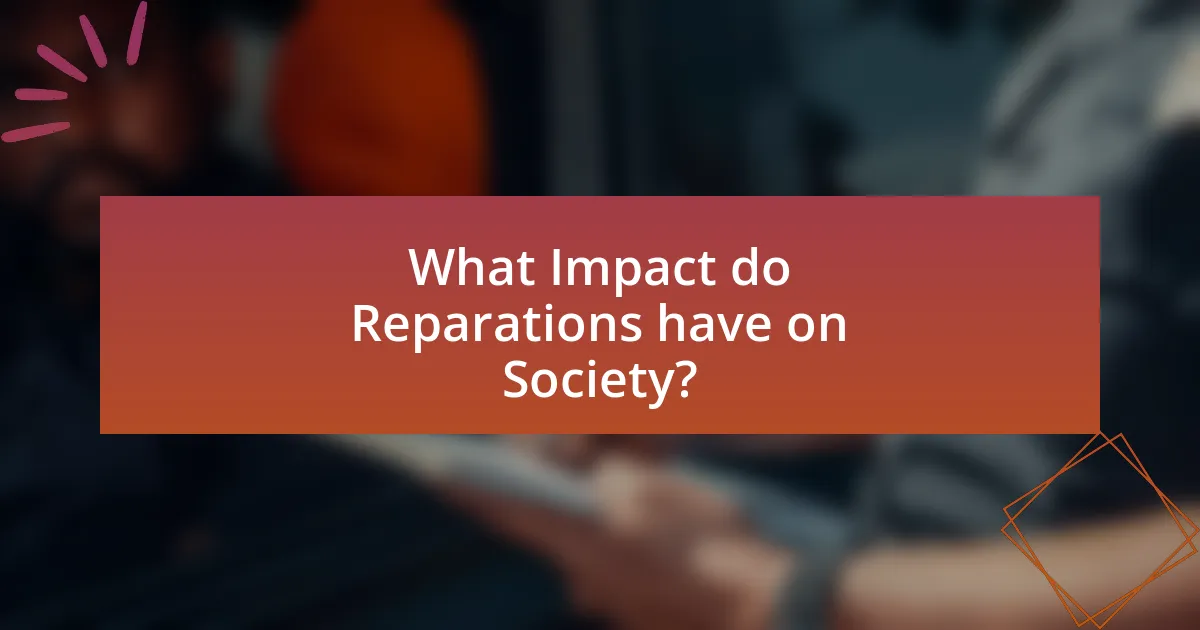
What Impact do Reparations have on Society?
Reparations have a significant impact on society by addressing historical injustices and promoting social healing. They serve to acknowledge the suffering of marginalized groups, thereby fostering a sense of recognition and validation. For instance, countries like South Africa implemented reparations post-apartheid, which aimed to restore dignity and support economic empowerment for affected communities. Research indicates that reparations can lead to improved social cohesion and reduced tensions among different societal groups, as seen in the case of Germany’s reparations to Holocaust survivors, which contributed to reconciliation efforts. Furthermore, studies show that reparations can stimulate economic development by investing in education and infrastructure in historically disadvantaged areas, ultimately benefiting society as a whole.
How do Reparations affect victims and communities?
Reparations positively affect victims and communities by providing financial compensation, acknowledgment of harm, and fostering social healing. Financial compensation can alleviate economic disparities caused by historical injustices, as seen in the case of Japanese American internment survivors, who received reparations in the form of $20,000 payments, which helped restore some economic stability. Acknowledgment of harm through reparations can validate victims’ experiences, contributing to psychological healing and community cohesion, as evidenced by the Truth and Reconciliation Commission in South Africa, which aimed to address the injustices of apartheid. Additionally, reparations can promote social justice and reduce systemic inequalities, thereby strengthening community resilience and fostering a sense of belonging among marginalized groups.
What long-term benefits can arise from successful reparations?
Successful reparations can lead to long-term benefits such as social cohesion, economic empowerment, and acknowledgment of historical injustices. Social cohesion is fostered as reparations can help bridge divides between affected communities and the broader society, promoting reconciliation and reducing tensions. Economic empowerment occurs when reparations provide financial resources or opportunities that enable marginalized groups to improve their living conditions, thereby contributing to overall economic stability. Furthermore, acknowledgment of historical injustices through reparations can validate the experiences of victims, fostering a sense of dignity and recognition that is essential for healing and moving forward. Historical examples, such as Germany’s reparations to Holocaust survivors, illustrate how such measures can lead to societal healing and integration over time.
How do reparations influence societal attitudes towards justice?
Reparations significantly influence societal attitudes towards justice by fostering a sense of acknowledgment and accountability for historical injustices. When reparations are implemented, they serve as a formal recognition of past wrongs, which can shift public perception towards a more restorative view of justice. For instance, studies have shown that countries like South Africa, which incorporated reparations into their transitional justice framework post-apartheid, experienced a greater societal dialogue about racial injustices and healing processes. This acknowledgment can lead to increased trust in institutions and a collective movement towards reconciliation, as evidenced by the Truth and Reconciliation Commission’s findings that reparations contributed to societal healing and a more equitable understanding of justice.
What Lessons can be Learned from Past Reparations Programs?
Past reparations programs demonstrate that successful implementation requires clear objectives, community involvement, and adequate funding. For instance, the German reparations to Holocaust survivors, initiated in the 1950s, highlighted the importance of acknowledging historical injustices and providing financial compensation, which helped in rebuilding trust and facilitating healing. Additionally, the South African Truth and Reconciliation Commission’s reparations efforts revealed that inclusive dialogue and recognition of victims’ experiences are crucial for fostering societal reconciliation. These examples underscore that reparations must be tailored to the specific context and needs of affected communities to be effective.
What case studies provide insight into effective reparations?
Case studies that provide insight into effective reparations include the South African Truth and Reconciliation Commission (TRC) and the reparations program in Germany for Holocaust survivors. The South African TRC, established in the 1990s, aimed to address human rights violations during apartheid by offering reparations to victims, which included financial compensation, education, and health services. This approach highlighted the importance of acknowledgment and public discourse in the healing process. In Germany, the reparations program initiated in the 1950s provided financial compensation to Holocaust survivors, demonstrating a long-term commitment to addressing historical injustices and fostering reconciliation. Both case studies illustrate that effective reparations require a combination of financial support, acknowledgment of harm, and mechanisms for public engagement to facilitate healing and social cohesion.
How can these lessons inform future reparations initiatives?
Lessons from past reparations initiatives can inform future efforts by highlighting the importance of community involvement and tailored approaches. Historical examples, such as the reparations for Japanese Americans interned during World War II, demonstrate that inclusive processes that engage affected communities lead to more effective outcomes. Additionally, the South African Truth and Reconciliation Commission showed that reparations must address both material and symbolic needs to foster healing and reconciliation. These cases underscore the necessity of comprehensive frameworks that consider the specific historical and cultural contexts of affected populations, ensuring that reparations are not only compensatory but also restorative.
What Best Practices should be Followed in Designing Reparations Programs?
Best practices in designing reparations programs include ensuring inclusivity, establishing clear eligibility criteria, and providing a range of reparative measures. Inclusivity ensures that all affected groups are represented, which is crucial for legitimacy and acceptance; for instance, the South African Truth and Reconciliation Commission emphasized the importance of including diverse voices to address historical injustices. Clear eligibility criteria help to define who qualifies for reparations, thereby preventing ambiguity and potential disputes; the case of Germany’s reparations to Holocaust survivors illustrates the effectiveness of well-defined criteria. Offering a variety of reparative measures—such as financial compensation, social services, and community development—addresses the multifaceted needs of victims, as seen in the reparations programs implemented in Colombia, which aimed to restore dignity and support recovery.
How can inclusivity and transparency be ensured in reparations processes?
Inclusivity and transparency in reparations processes can be ensured by actively involving affected communities in decision-making and maintaining open communication throughout the process. Engaging stakeholders, including victims and marginalized groups, allows for diverse perspectives and needs to be addressed, which is crucial for the legitimacy of reparations. For instance, the Truth and Reconciliation Commission in South Africa emphasized community participation, leading to more comprehensive reparative measures. Additionally, establishing clear guidelines and publicly accessible information about the reparations process fosters accountability and trust, as seen in the reparations programs in Germany for Holocaust survivors, which provided transparent criteria for eligibility and compensation.
What role does monitoring and evaluation play in successful reparations?
Monitoring and evaluation are critical for successful reparations as they ensure accountability, assess the effectiveness of reparative measures, and facilitate stakeholder engagement. By systematically tracking the implementation of reparations programs, monitoring allows for the identification of gaps and challenges, enabling timely adjustments to enhance outcomes. Evaluation provides evidence-based insights into the impact of reparations on affected communities, measuring changes in social, economic, and psychological well-being. For instance, the International Center for Transitional Justice emphasizes that effective monitoring and evaluation frameworks can lead to improved trust in institutions and greater community satisfaction with reparative efforts.

